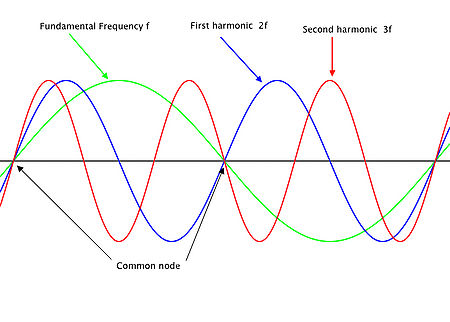Harmonics: Difference between revisions
(added internal link) |
|||
| Line 31: | Line 31: | ||
==External links== | ==External links== | ||
{{electronics}} | |||
Revision as of 17:27, 8 April 2009
Related wiki pages: Antennas, Propagation, Interference, Gain, SWR, Frequency Wavelength and Period
What is an harmonic?
An harmonic of a particular frequency (the fundamental frequency f) is another frequency that is an integer multiple of the first one. For example:
if f = 125MHz, the harmonics would be: 2f = 250MHz, 3f = 375MHz, 4f = 500MHz ..... etc
In the diagram below it can be seen that harmonics share common nodes.
Mathematically, the basic wave equation is:
<math> \mathit{v}=\mathit{f}\times \lambda </math>
v is the velocity of the wave in metres per second - a constant close to the speed of light for radio waves in the atmosphere.
f is the frequency of the wave - how many cycles pass a fixed point per second
<math> \lambda </math> is the wavelength of the wave in metres - the distance between two peaks of the wave.
So, as the frequency increases, the wavelength decreases - a doubling of frequency causes a halving of wavelength etc.
Where do harmonics come from?
Why are harmonics bad?
How do you get rid of harmonics?
External links
| Electronic Theory | |
| Physical quantities | Current * Gain * Impedance * Power * Q of a circuit * Radiated Power Measurement * Reactance* Resistivity * Resonance * Voltage |
| Components | Baluns * Bipolar-Junction Transistors * Capacitors * Diodes * Inductors* Lasers * Microphones * Resistors * Transformers * Wire |
| Circuits | Attenuators * Digital Signal Processing (DSP) * Dummy load * Filters * LC filters * Power Supply Design * Rectifier Circuits |
| Design | Amplifier Design * Oscillator Design |
| Electromagnetic Waves | Relative power (Decibels) * Harmonics * Interference and BPL |
